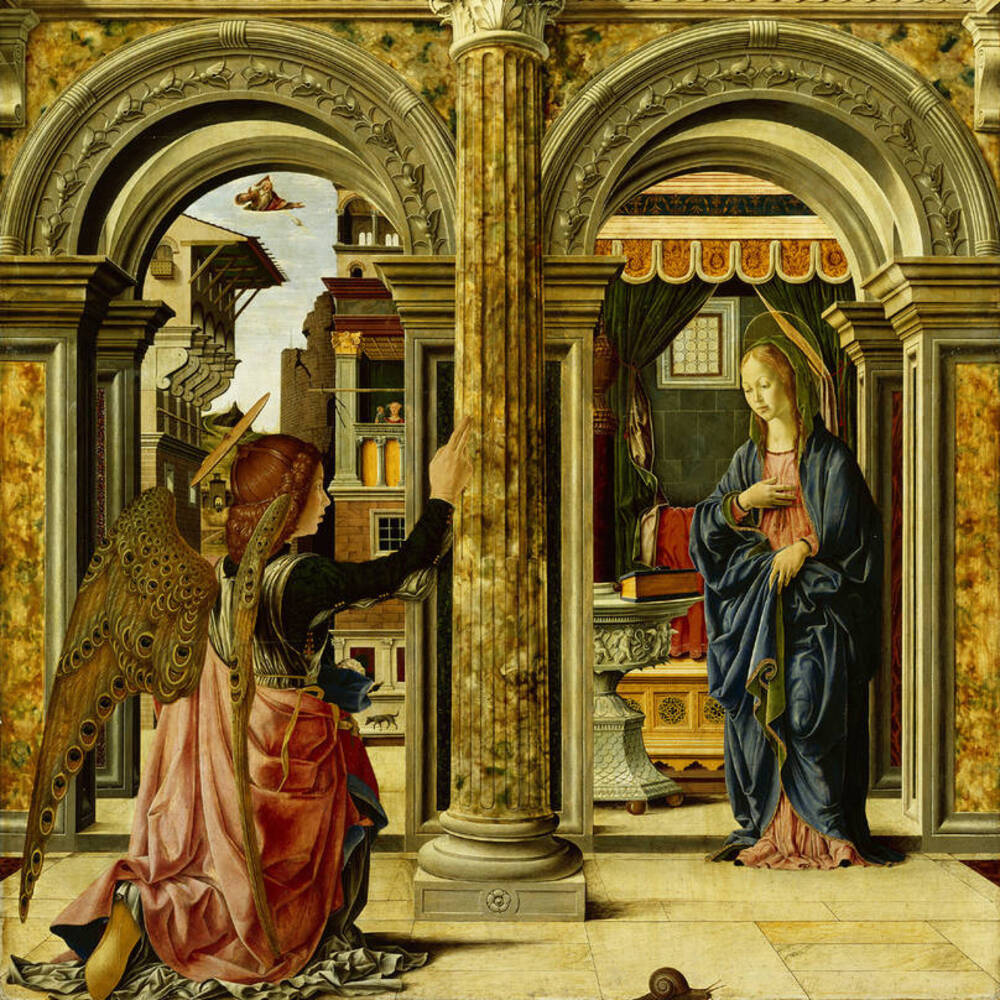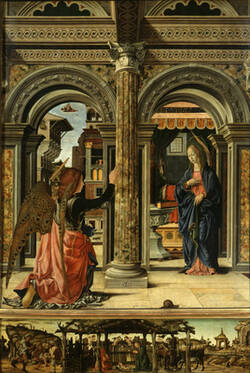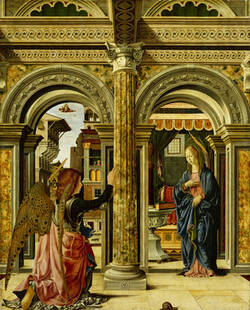The discovery of how to apply perspective was one of the most important advances of the Renaissance. Here, the Ferrarese artist demonstrates in an exemplary way how all the lines of the architecture vanish towards a single point. This makes the rooms appear real. The altarpiece shows the Archangel Gabriel announcing to the Virgin Mary that she would conceive and give birth to Jesus. The snail is a symbol of Mary’s virginity. The altar also includes the base (predella) depicting the Nativity.
Further Media







The Annunciation is recounted in Saint Luke’s Gospel:
‘And in the sixth month, the Angel Gabriel was sent from God to city in Galilee called Nazareth, to a virgin pledged to be married to a man named Joseph, a descendent of David. The virgin’s name was Mary.
Gabriel appeared to her and said, “Greetings, you who are highly favoured! The Lord is with you.” But Mary was greatly troubled at his words, and wondered what kind of greeting this might be. The angel said to her, “Do not be afraid, Mary, for you have found favour with God. And behold, you will conceive and bear a son, and you shall name him Jesus. He will he great and will be called the Son of the Most High. (…) And his kingdom will never end.”’
But Mary had sworn in the Temple to remain a virgin. Puzzled, she asked how all this could come to pass. Gabriel then explained the Holy Spirit would come upon her and the power of the Most High overshadow her. Ultimately, Mary complies with the divine will, and humbly replies,
‘I am the Lord’s servant; let it be to me according to your word.’
The story begins with the Roman Emperor issuing an edit requiring a tax census of all those living in the Empire. Everyone had to register in the town they where they were born – and so Joseph of Nazareth had to register in his home town of Bethlehem. He set off with his wife Mary, who was heavily pregnant.
But when they arrived, all the places to stay were already full. Ultimately, they found a place to shelter in a stable. There, Mary gave birth, and took a manger as a temporary cradle for her new-born son. Soon the first visitors arrived – in the night Jesus was born, a host of angels appeared to shepherds tending their flocks nearby and told them of the glad tidings.
The snail directly on the lower edge of the painting looks deceptively real – almost as though it is creeping along the frame! Does the snail have a special meaning? Or is it just a humorous little touch added by the artist Francesco del Cossa?
Even the renowned German writer Johann Wolfgang von Goethe gave some thought to the matter. In her memoirs, the artist Louise Seidler, one of Goethe’s contemporaries, recalled how she met him here in the Dresden art gallery and asked him about the snail’s significance. He instructed her:
‘This snail is an embellishment, my dear lady, put here on a whim by the artist!’
But in this case, Goethe was a long way off the mark. In fact, the snail symbolises Mary’s purity and innocence – reflecting the widespread belief when this work was painted that snails were fertilized by the dew.
Take a moment to compare Mary’s halo with the angel’s. Mary’s transparent halo seems to float elegantly behind her head. In contrast, the angel Gabriel’s halo appears artificial, an attachment made of wood and metal. Such artificial halos were part of the props used in medieval mystery plays. But as yet scholars have not found out why Francesco del Cossa equipped his angel Gabriel with a halo for a mystery play.
‘Predella’ comes the Italian and means a little step or a stool. In art, the predella is the term for the horizontal band under the main panels of an altarpiece. An altarpiece is set at the rear of the altar – and sometimes known as a ‘retable’, derived from the Latin retro tabulum, ‘behind the altar’ . In a church, an altarpiece is one of the most prominent features, and can be decorated with large format paintings or carved figures. Adding wing panels to the central panel created more space for the iconographic programme. On particularly elaborate altarpieces, the wing panels are painted on both sides. In this way, opening or closing the wings presents different scenes to the faithful.
- Location & Dating
- c. 1470/72
- Material & Technique
- Tempera on poplar panel
- Dimenions
- 139 x 113,5 cm
- Museum
- Gemäldegalerie Alte Meister
- Inventory number
- Gal.-Nr. 43